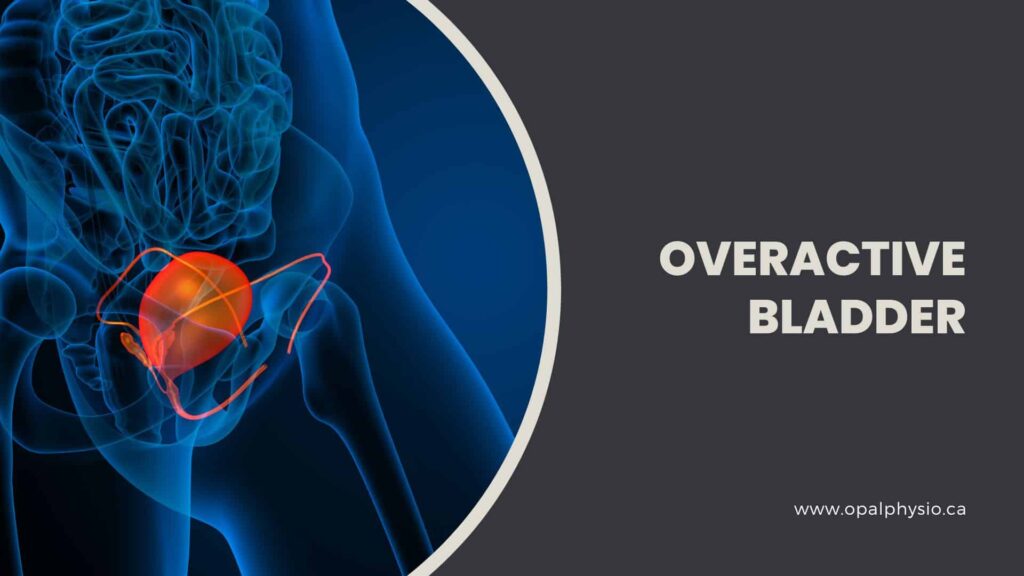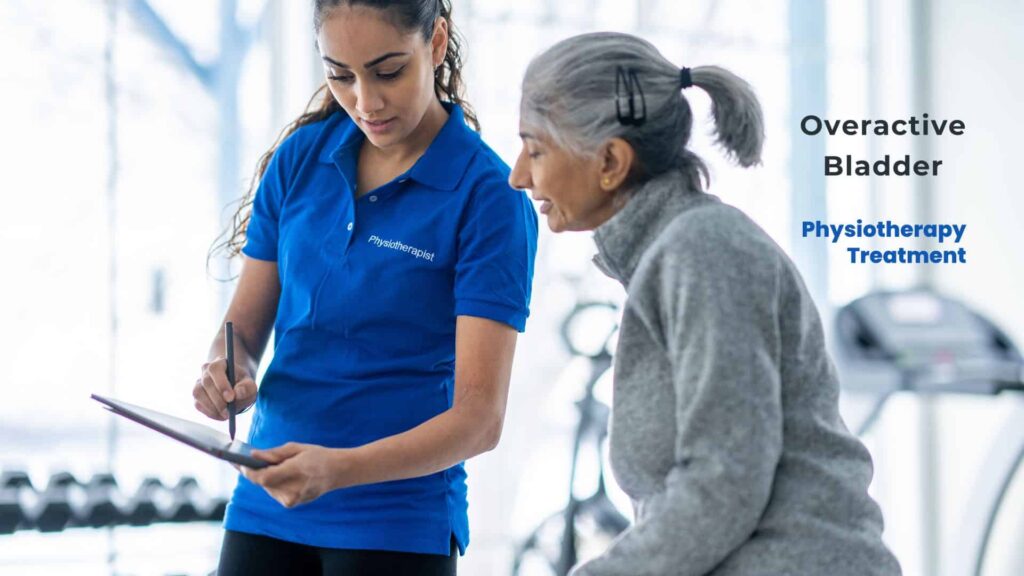Overactive Bladder Treatment in Langley
Do you find yourself constantly rushing to the restroom?
Struggling with an Overactive Bladder (OAB) can be frustrating and can have a significant impact on your daily life.
Physiotherapy for Overactive Bladder
For many individuals struggling with OAB symptoms, physiotherapy offers an effective, non-invasive treatment option that can significantly improve quality of life.
Physiotherapy for overactive bladder focuses on strengthening and retraining the pelvic floor muscles to enhance bladder control. This specialized form of physical therapy utilizes various techniques and exercises tailored to each patient’s needs. The primary goals are to reduce urinary frequency, urgency, and episodes of incontinence while increasing bladder capacity and improving overall pelvic floor function
At Opal Physio, our team of expert physiotherapists is here to help you regain control with our specialized pelvic floor therapy for overactive bladder in Langley.

What is an overactive bladder?
Overactive bladder (OAB), also known as urinary Incontinence, is where a person experiences a frequent urgency and need for urination with associated incontinence. This is caused by involuntary muscle contractions in the walls of the urinary bladder, causing the bladder to empty too quickly, resulting in frequent urination.
An OAB can affect men and women equally, although it tends to occur most frequently among older adults. These problems are often associated with stress or anxiety, and it is important to get treatment.
Symptoms of Overactive Bladder
Overactive bladder (OAB) is characterized by several key symptoms:
- Urgency: A sudden, strong urge to urinate that is difficult to control.
- Frequency: Urinating 8 or more times in a 24-hour period.
- Nocturia: Waking up 2 or more times at night to urinate.
- Urge incontinence: Involuntary loss of urine immediately following an urgent need to urinate.
Other common symptoms include:
- Feeling the need to urinate even if you have just used the toilet.
- Taking many trips to the toilet only to urinate a small amount each time.
- Bladder spasms.
- Having to strain to pass urine
- Painful or burning sensations while passing urine
- Difficulty holding urine when you feel the urge to go.
It’s important to note that not everyone with OAB experiences all of these symptoms, and the severity can vary from person to person. Some people may have “dry” OAB, where they experience urgency and frequency without incontinence, while others may have “wet” OAB, which includes urge incontinence.
OAB can significantly impact quality of life, causing embarrassment, social isolation, and disruption of daily activities and sleep patterns. If you’re experiencing these symptoms, it’s advisable to consult a healthcare provider for proper diagnosis and treatment, as OAB is a manageable condition with various treatment options available.
What happens in an overactive bladder?
In a normal bladder function, the kidneys produce urine which travels to the bladder. Then, the brain sends signals that tell the body to urinate, causing the pelvic floor muscles to relax and the bladder to contract. However, in people with an OAB, the bladder muscles contract involuntarily, causing a sudden and urgent need to urinate, even when the bladder is not full. This can lead to frequent urination, incontinence, and waking up frequently to urinate at night.
Causes of overactive bladder
Several conditions may contribute to signs and symptoms of OAB, including neurological disorders, such as stroke and multiple sclerosis, diabetes, urinary tract infections, and hormonal changes during menopause in women.
Why choose our clinic for overactive bladder treatment in Langley?
At Opal Physio, we understand the physical and emotional toll an OAB can have on your life. Our experienced and dedicated physiotherapists are committed to providing personalized care for your unique needs. With the latest equipment and techniques, we strive to offer the best overactive bladder physiotherapy treatment in Langley.

How does physiotherapy treatment for overactive bladder work?
Physiotherapy is the first-line treatment for overactive bladder. Physiotherapy treatment for an OAB focuses on strengthening the muscles that control your bladder, known as the pelvic floor muscles. This conservative treatment is safe, non-invasive and an alternative to surgical intervention.
Skilled physiotherapists will work with you to create a targeted exercise plan designed to improve muscle control and alleviate symptoms. Treatment may include:
- Pelvic floor exercises
- Core strength training
- Postural training
- Biofeedback
- Bladder training
- Lifestyle modifications and advice
The physiotherapist’s role is to provide advice and treatment for OAB, a common problem affecting women.
Benefits of overactive bladder physiotherapy treatment
By choosing OAB physiotherapy treatment, you can expect the following:
- Decreased frequency of bathroom visits
- Enhanced bladder control
- Reduced risk of incontinence
- Reduced risk of infections
- Improved sleep quality
- Eliminate the use of incontinence products
- Improved well-being
Get started with overactive bladder physiotherapy treatment in Langley
Don’t let an overactive bladder control your life any longer. Trust the experts at Opal Physio in Langley to provide the effective, personalized care you deserve. If you are looking for overactive bladder treatment near me contact us today to schedule a consultation and take the first step towards improved bladder control and a more confident you.
Opal Physio – Your trusted provider of overactive bladder physiotherapy treatment in Langley. Get the care you need and reclaim your life today!
